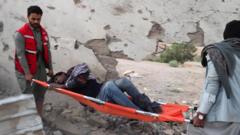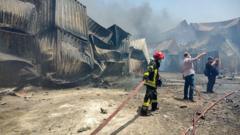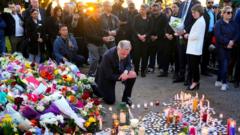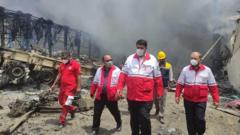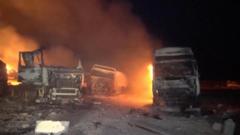A recent explosion in Yemen's capital has ignited a debate over responsibility, with the U.S. denying involvement and attributing the incident to a Houthi missile strike.
U.S. Claims Yemen Blast Was Caused by Houthi Missile, Not American Airstrike

U.S. Claims Yemen Blast Was Caused by Houthi Missile, Not American Airstrike
Dispute over a deadly explosion in Yemen raises questions about combat operations in the region.
In a tragic incident in Sana, Yemen, an explosion that claimed the lives of 12 people and injured around 30 occurred near a UNESCO world heritage site on Sunday. Initial reports from officials associated with the Houthi-led government pointed to a U.S. airstrike as the primary cause of the destruction; however, U.S. Central Command later clarified that their military operations that night did not directly cause the damage.
According to Dave Eastburn, a spokesman for U.S. Central Command, the closest American operation was conducted more than three miles away from the explosion's location. He further asserted that the blast resulted from a “Houthi Air Defense missile.” The Pentagon’s claim was bolstered by an analysis of local reports and videos that purportedly documented missile fragments featuring Arabic script.
Conversely, an early report by The New York Times highlighted that a video showing such missile shrapnel appeared to originate from a different site than the blast's location, leading to doubts regarding the U.S. military's assertions. Mohammed al-Bukhaiti, a member of the Houthis’ Politburo, dismissed the U.S. claims as an attempt at discrediting the group. He reiterated their belief that the U.S. was indeed responsible for the attack, positing that similar operations have previously harmed civilians, including strikes on ports and cemeteries.
This incident underscores the ongoing complexities and dangers entrenched in Yemen's civil conflict, as well as the broader ramifications of foreign military involvement in the region.
According to Dave Eastburn, a spokesman for U.S. Central Command, the closest American operation was conducted more than three miles away from the explosion's location. He further asserted that the blast resulted from a “Houthi Air Defense missile.” The Pentagon’s claim was bolstered by an analysis of local reports and videos that purportedly documented missile fragments featuring Arabic script.
Conversely, an early report by The New York Times highlighted that a video showing such missile shrapnel appeared to originate from a different site than the blast's location, leading to doubts regarding the U.S. military's assertions. Mohammed al-Bukhaiti, a member of the Houthis’ Politburo, dismissed the U.S. claims as an attempt at discrediting the group. He reiterated their belief that the U.S. was indeed responsible for the attack, positing that similar operations have previously harmed civilians, including strikes on ports and cemeteries.
This incident underscores the ongoing complexities and dangers entrenched in Yemen's civil conflict, as well as the broader ramifications of foreign military involvement in the region.


